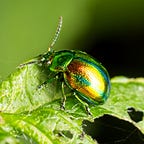Why Such an Obsession with Dew?
Nature photographers love to shoot pictures with dew. Why is that?
Nature photographers seem to be extremely fond of dew. In particular macro shots of flowers and insects often contain dew. And also many landscape photographers love nature that is covered with dew, preferably combined with mist. Why is this? What is the attraction of dew?
I recently read a book on photographing butterflies and dragonflies. About half the images in the book showed insects covered in dew, and the authors were very enthusiastic about that. Some of these shots I really liked, but for many others I had the feeling that the dew was just obstructing a nice clean view of the many intricate details and colors of the insects. It made the images too busy. But a similar shot, where there was no dew on the butterfly, was labelled as a simple “registration”.
Unusual
I think that many photographers aim for shots that are somewhat unusual. And due to their long experience as a nature photographer, most shots are not unusual enough for them. They have photographed so many butterflies or flowers, that any “normal” shot is boring. And dew definitely makes subjects unusual. Unless, of course, it is applied too often. Who has not photographed a close-up of a spider web with dew drops, like in the image below? I think it would be more challenging to make an interesting shot of a web without dew.
Making the uninteresting interesting
Some object are not very interesting to photograph. A green leaf on tree can be pretty boring. So there is a challenge to turn it into something special. There are lots of techniques for this, but using dew is one of them.
Dew can also bring out detail that is otherwise hidden, like small hairs. It is one of the reasons spider webs with dew can look more interesting.
Getting up early
To photograph dew, you have to get up early, and preferably be there before sunrise. That is something that many of us are not willing to do for a photograph, especially in summer. So, as a photographer, you become someone special when you photograph subjects with dew on them. Especially, if you also use the backlight caused by the rising sun.
Using a tripod
Many macro photographers prefer to use a tripod. It makes it easier to get the perfect composition with the perfect focus. But a tripod only works when the subject is not moving at all. There should be no wind, and, when you are shooting insects, the insect should sit motionless. Also, you need a lot of time to set up the tripod. So an insect should not fly away.
The best circumstances for this exist very early in the morning after a cold night. There is often little wind in that situation. And insects cannot move until they have warmed up, so they will sit still and you have plenty of time to take the shot.
But an early morning after a cold night is also the perfect time for dew. So if you take your shots in that situation, you often have dew on your subjects. So, maybe, the dew is not always an artistic choice but it is a side-effect of the circumstances you need to take your shot.
Mark Overmars is a dedicated insect photographer that loves to share and regularly publishes about his work and about photography in general. You can visit his website at www.insectphotography.org. Download his free insect photography book at www.insectphotography.org/book.
